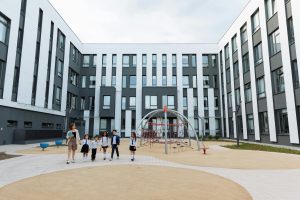The future of hybrid and flexible school models
In recent years, the education system has undergone a significant transformation, moving away from traditional classroom models towards more flexible and innovative approaches. With the rapid advancement of technology and changing needs of students, the future of education is headed towards hybrid and flexible school models.
The Changing Landscape of Education
Gone are the days when students were bound to a rigid schedule, sitting in a classroom for hours on end. With the advent of online learning platforms, students can now access educational resources from the comfort of their own homes. This has opened up a world of possibilities for students, allowing them to learn at their own pace and in a way that suits their individual needs.
The Rise of Hybrid School Models
Hybrid school models have gained popularity in recent years, combining traditional classroom learning with online resources. In this model, students attend physical classes for some parts of the day or week, while the rest of their learning is done online. This approach offers the best of both worlds, providing students with face-to-face interaction with teachers, as well as the flexibility of online learning.
With hybrid models, students have the freedom to personalize their learning experience. They can choose to complete assignments and coursework online, take part in interactive online discussions, and access a wide range of educational resources at their fingertips. This not only caters to different learning styles but also prepares students for the digital world they will enter once they leave school.
The Benefits of Flexible School Models
Flexible school models take hybrid learning a step further by allowing students to have complete control over their education. This model eliminates the traditional classroom structure, giving students the freedom to design their own curriculum tailored to their interests, strengths, and goals.
In a flexible school model, students have the opportunity to explore subjects that may not be offered in a traditional school setting, such as coding, robotics, and entrepreneurship. They can also choose the pace at which they want to learn, allowing them to delve deeper into topics that interest them and move on from those that do not. This not only keeps students engaged but also helps them develop a love for learning.
The Future is Flexible
The benefits of hybrid and flexible school models extend beyond the classroom. The future job market will require individuals to have a diverse skillset and the ability to adapt quickly to changing circumstances. Flexible school models prepare students for this reality, equipping them with critical thinking, problem-solving, and time-management skills.
Furthermore, hybrid and flexible models are cost-effective, making education accessible to a broader population. Students from low-income households can benefit from the flexibility of online learning, while those with disabilities can have an inclusive learning experience. This promotes diversity and inclusivity in the education system.
The Importance of Google SEO in Education
As hybrid and flexible school models become increasingly popular, schools and educational institutions need to utilize Google SEO strategies to stand out from the competition. With more students turning to online learning, it is crucial for schools to rank highly on search engines to attract potential students.
Schools should invest in creating high-quality, informative content that is optimized for Google SEO. This includes using relevant keywords, creating backlinks, and having a mobile-friendly website. By following Google’s best practices, schools can increase their online visibility and reach a wider audience.
Final Thoughts
The future of education is paved with innovative and flexible school models. Hybrid and flexible models provide students with the opportunity to learn in a way that suits them best, preparing them for the ever-changing landscape of the digital world. With the right strategies in place, schools can effectively adapt to these changes and continue to provide a high-quality education for generations to come.










